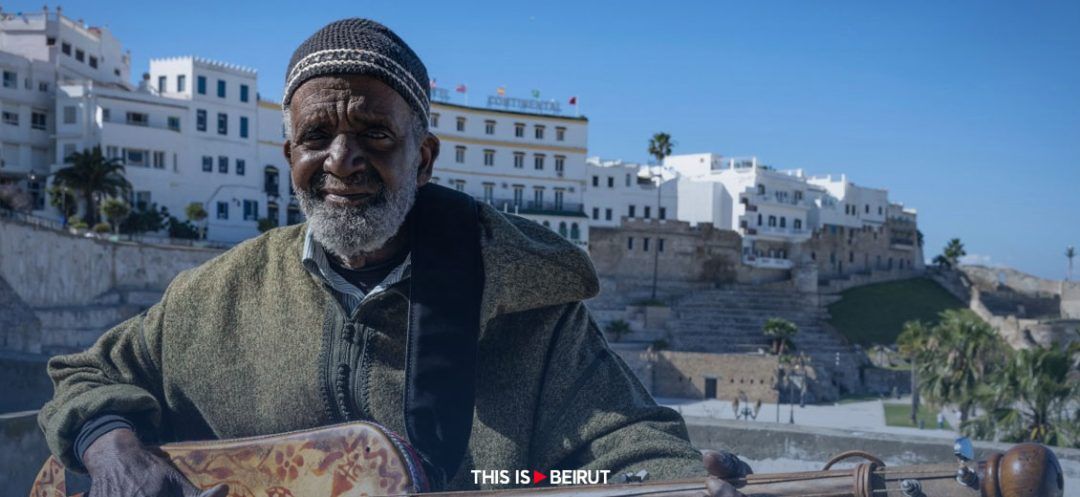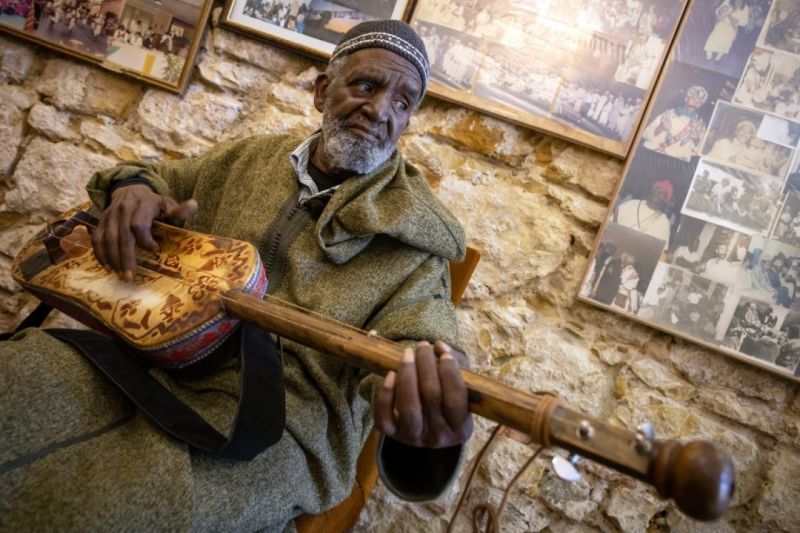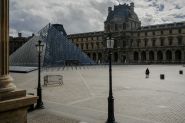
©Abdellah El Gourd a 77-year-old Moroccan legend of gnawa music - Photo by Fadel Senna/AFP
In the last century, Tangier became a captivating destination for renowned American jazz musicians, leaving a rich legacy that continues to inspire and enchant.
Tangier, the enchanting city nestled between the Mediterranean Sea and the Atlantic Ocean, has long been a magnet for artists, intellectuals and musicians from around the world. In the last century, this cosmopolitan metropolis in northern Morocco became a haven for American jazz legends, who crossed the Atlantic to explore its vibrant culture and discover their African roots. The city’s allure was so powerful that a writer once remarked, “There was always a steamship warming up in New York, bound for Tangier.”
The city’s appeal to jazz musicians was deeply rooted in its unique history. Tangier’s status as a former international zone, administered by several colonial powers from 1923 until Morocco’s independence in 1956, fostered a cosmopolitan atmosphere that attracted writers and poets from the “beat generation” movement, as well as African-American jazz musicians seeking to reconnect with their ancestral heritage. As Philippe Lorin, founder of the Tanjazz festival, aptly put it, “Tangier was a haven of freedom, just like jazz music.”
Among the most prominent jazz figures to make Tangier their home was the renowned pianist Randy Weston. After a tour of 14 African countries in 1967, organized by the US State Department, Weston settled in Tangier for five years. His presence and influence were instrumental in shaping the city’s jazz mythology, as evidenced by his 1973 album Tanjah, dedicated to the city of the strait.
 Abdellah El Gourd a 77-year-old Moroccan legend of gnawa music -Photo by Fadel Senna/AFP
Abdellah El Gourd a 77-year-old Moroccan legend of gnawa music -Photo by Fadel Senna/AFP
Weston’s impact on Tangier’s music scene was profound, as he collaborated with local artists and helped to bridge the gap between jazz and traditional Moroccan music. Abdellah El Gourd, a master of Gnawa music (a spiritual genre originating from West Africa, brought by the descendants of slaves), became a close friend and collaborator of Weston. “Randy was an exceptional man, kind and respectful. He gave a lot to the city and its musicians,” El Gourd fondly recalls.
Another pivotal moment in Tangier’s jazz history was the recording of a 1959 musical session featuring the venerable trumpeter Idrees Sulieman, pianist Oscar Dennard, bassist Jamil Nasser, and drummer Buster Smith at the Radio Tanger International (RTI) studio. The session, initiated by Jacques Muyal, an 18-year-old Tangier native and jazz radio host, resulted in a landmark album that would circulate in jazz circles before its official release as The 4 American Jazzmen In Tangier in 2017.
Weston and El Gourd’s collaboration pushed the boundaries of musical creation, as they became pioneers in the fusion of jazz and Gnawa sounds. “The language barrier was never a problem because our communication was through the scales. Our language was music,” El Gourd explains, surrounded by photographs of international tours, with Weston and saxophonist Archie Shepp, in his rehearsal room. Their long-standing partnership culminated in the 1992 album The Splendid Master Gnawa Musicians of Morocco.
In 1969, Weston opened a jazz club called the African Rhythms Club above the famous Mauritania cinema. “We rehearsed there, and Randy invited his musician friends. It was a beautiful time,” reminisces the 77-year-old master, who traveled the world alongside Weston.
Three years later, the American pianist embarked on the ambitious endeavor of organizing Tangier’s first jazz festival, featuring renowned guests such as percussionist Max Roach, flutist Hubert Laws, bassist Ahmed Abdul-Malik, saxophonist Dexter Gordon, and, of course, Abdellah El Gourd. “It was quite a unique experience because it was the first time we played in front of such a large audience,” El Gourd recalls, having been accustomed to intimate Gnawa performances.
Although the festival only lasted one edition, it inspired Philippe Lorin to create the Tanjazz festival nearly three decades later, which continues to celebrate the city’s rich jazz heritage every September.
Tangier’s jazz legacy, forged by the passion and creativity of American musicians who found solace and inspiration in its vibrant culture, remains an integral part of the city’s identity. As the UNESCO-designated host city for International Jazz Day this year, Tangier proudly celebrates its place in jazz history, with a series of conferences, outdoor performances, and a grand global concert featuring renowned artists such as pianist Herbie Hancock, bassists Marcus Miller and Richard Bona, and guitarist Romero Lubambo.
With AFP
Tangier, the enchanting city nestled between the Mediterranean Sea and the Atlantic Ocean, has long been a magnet for artists, intellectuals and musicians from around the world. In the last century, this cosmopolitan metropolis in northern Morocco became a haven for American jazz legends, who crossed the Atlantic to explore its vibrant culture and discover their African roots. The city’s allure was so powerful that a writer once remarked, “There was always a steamship warming up in New York, bound for Tangier.”
The city’s appeal to jazz musicians was deeply rooted in its unique history. Tangier’s status as a former international zone, administered by several colonial powers from 1923 until Morocco’s independence in 1956, fostered a cosmopolitan atmosphere that attracted writers and poets from the “beat generation” movement, as well as African-American jazz musicians seeking to reconnect with their ancestral heritage. As Philippe Lorin, founder of the Tanjazz festival, aptly put it, “Tangier was a haven of freedom, just like jazz music.”
Among the most prominent jazz figures to make Tangier their home was the renowned pianist Randy Weston. After a tour of 14 African countries in 1967, organized by the US State Department, Weston settled in Tangier for five years. His presence and influence were instrumental in shaping the city’s jazz mythology, as evidenced by his 1973 album Tanjah, dedicated to the city of the strait.
 Abdellah El Gourd a 77-year-old Moroccan legend of gnawa music -Photo by Fadel Senna/AFP
Abdellah El Gourd a 77-year-old Moroccan legend of gnawa music -Photo by Fadel Senna/AFPWeston’s impact on Tangier’s music scene was profound, as he collaborated with local artists and helped to bridge the gap between jazz and traditional Moroccan music. Abdellah El Gourd, a master of Gnawa music (a spiritual genre originating from West Africa, brought by the descendants of slaves), became a close friend and collaborator of Weston. “Randy was an exceptional man, kind and respectful. He gave a lot to the city and its musicians,” El Gourd fondly recalls.
Another pivotal moment in Tangier’s jazz history was the recording of a 1959 musical session featuring the venerable trumpeter Idrees Sulieman, pianist Oscar Dennard, bassist Jamil Nasser, and drummer Buster Smith at the Radio Tanger International (RTI) studio. The session, initiated by Jacques Muyal, an 18-year-old Tangier native and jazz radio host, resulted in a landmark album that would circulate in jazz circles before its official release as The 4 American Jazzmen In Tangier in 2017.
Weston and El Gourd’s collaboration pushed the boundaries of musical creation, as they became pioneers in the fusion of jazz and Gnawa sounds. “The language barrier was never a problem because our communication was through the scales. Our language was music,” El Gourd explains, surrounded by photographs of international tours, with Weston and saxophonist Archie Shepp, in his rehearsal room. Their long-standing partnership culminated in the 1992 album The Splendid Master Gnawa Musicians of Morocco.
In 1969, Weston opened a jazz club called the African Rhythms Club above the famous Mauritania cinema. “We rehearsed there, and Randy invited his musician friends. It was a beautiful time,” reminisces the 77-year-old master, who traveled the world alongside Weston.
Three years later, the American pianist embarked on the ambitious endeavor of organizing Tangier’s first jazz festival, featuring renowned guests such as percussionist Max Roach, flutist Hubert Laws, bassist Ahmed Abdul-Malik, saxophonist Dexter Gordon, and, of course, Abdellah El Gourd. “It was quite a unique experience because it was the first time we played in front of such a large audience,” El Gourd recalls, having been accustomed to intimate Gnawa performances.
Although the festival only lasted one edition, it inspired Philippe Lorin to create the Tanjazz festival nearly three decades later, which continues to celebrate the city’s rich jazz heritage every September.
Tangier’s jazz legacy, forged by the passion and creativity of American musicians who found solace and inspiration in its vibrant culture, remains an integral part of the city’s identity. As the UNESCO-designated host city for International Jazz Day this year, Tangier proudly celebrates its place in jazz history, with a series of conferences, outdoor performances, and a grand global concert featuring renowned artists such as pianist Herbie Hancock, bassists Marcus Miller and Richard Bona, and guitarist Romero Lubambo.
With AFP
Read more



Comments